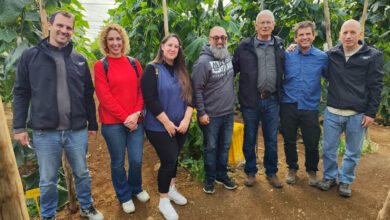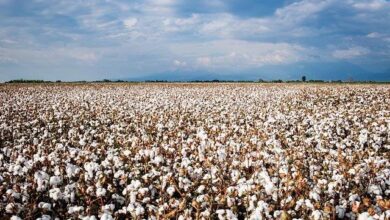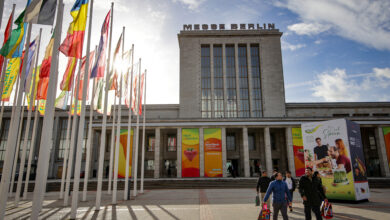Agri-Voltaic System Impact on Wine Grapevines in an Arid Environment

Amnon Bustan, Ramat Negev Desert Agro-Research Center* amnonbustan@gmail.com
Introduction
The grapevine (Vitis vinifera) is deeply intertwined in the culture and history of the Land of Israel. Wine vines were grown in the Negev desert to such an extent that it was possible to export reputable wines (Gaza and Ashkelon wines) to all the countries of the Mediterranean basin – until the sixth century AD. This industry collapsed for various reasons, mostly unknown, and was revived only at the end of the last century. The extent of the wine vineyards in Ramat Negev today is over 1500 dunams and the plantings are expanding. Several wineries have been established in the area, which succeed in developing a reputation for wine quality and uniqueness.
Alongside this success, the problems arising from the location of the region at the hot and dry southern end of the classic ‘wine belt’ (northern hemisphere) are getting more and more acute. The wine vines here experience a temperature range that is classified as extremely hot, perhaps even beyond the practicability threshold. The problem becomes particularly acute in the summer months, June-August, and challenges the berries yield and quality toward harvest and, as a result, the quality of the wines.
The high temperature at Ramat Negev in summer is partly due to high levels of solar radiation reaching the ground in the absence of cloud cover and relatively low humidity during daylight hours. Most of the agricultural crop species, including grapevines, do not requirethe flux of solar radiation that usually prevails in the Negev every summer day between 09:00-15:00 (600-1100 watts/m2/s) but are rather damaged; most crops may be satisfied with about half radiation levels or less. The key to success in growing wine vines and producing quality wine in such desert conditions lies in creating a microclimate that is less hot and more favorable for fruit development.Shading is the first solution that comes to mind; however, experimental results tell that the daily shading regime must be managed according to the vine requirements underthe prevailing environmental conditions. Nevertheless, the cost of such smart manageable shading systems is beyond the economic capacity of most agricultural crops.
Following climate change and its arrival at the doorstep of decision makers, the need to develop renewable energy sources is increasing.In Israel, combining agricultural activity with electricity production from photovoltaic installations (agri-voltaic) is the most promising avenue. The combinedrevenues will significantly increase the income per unit of agricultural area. Furthermore, it may support the establishment and operation of intelligent shading facilities. Yet, the agri-voltaic vision poses complex scientific, technological and economic challenges. This is a pioneering field, in which there is relatively little practical experience and beyond that, maximum adaptation to the place of application is required, in all respects;what has been learnt and demonstrated in France is not necessarily true and relevant to the Negev.
The research in Ramat Negev is the cutting edge of the world’s wine culture in dealing with the consequences of the climate change that already take place before our eyes in classic wine regions worldwide. Ramat Negev Desert Agro-Research Center (RNDARC) acts in close cooperation with Agri-Light Energy Systems Ltd. to establish a training and demonstration facility in the station’s vineyard. Agri-Light Energy Systems has a unique patent for the technology of a horizontal movement of solar panels above the plants’ canopy, thus providing maximum management of the light and shade temporal location in the vineyard, orchard and other row crops.
The goals set for 2024 were as follows:
a. Establishing an Agri-Light facility in RNDARC vineyard;
b. Operating the facility while monitoring and controlling the movement of the solar panels according to the plan and operating model;
c. Placing environmental, soil and plant sensors to study the effect of the facility on physiological indicators in selected grape varieties on a daily basis;
d. Monitoring the development of the fruit and its ripening in the varieties under the facility and in the control.
Materials and methods
The vineyard, located at RNDARC in Ramat Negev, Israel, was designed to examine 30 commercial wine grapevine cultivars (10 white, and 20 red) and planted in 2012, with a row direction closely north-south. Each cultivar is represented by 32 vines, divided into 4 replications (random box design).
Agri-Light solar ceiling is designed so the panels can move horizontally above the grapevine row, covering 37% of the ground below; the location of the shade, either on the grapevine row or between is completely determined by the operator (Photo. 1).Principally,the system algorithm is designed to favor crop current requirements/restrictions for lightand air temperature that are continuously measured. Many other environmental and plant parameters are followed, including soil moisture; photosynthetic active radiation (PAR); leaf temperature; and, various photochemical reflectance indices (PRI). Sensors and data acquisition and management is provided by Seymour Ag Instruments Ltd., Israel.
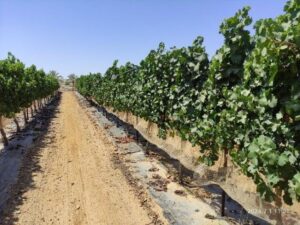

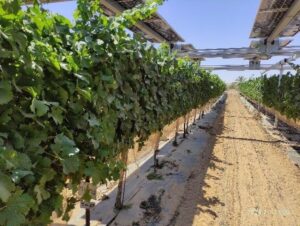
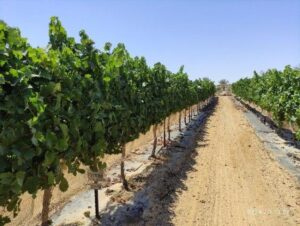
Photograph 1. Agri-Light solar ceiling above RNDARC vineyard (left), vs.control (right). Late morning (11:00) in July, the eastern facade of the grapevine row (above)is already under the solar shade, receiving soft diffuse radiation,whilethe control eastern foliageis exhausted from the scorching sun.At the same time, the western façade (below) is still in natural shade, under both treatments. Later on, the western façade is kept in a solar shade until late afternoon.
Results and discussion
The construction of the agri-voltaic facility above the vineyard lasted much longer than planned and was only completed in April-May 2024, after budburst and the beginning of the growing season. Bringing the facility to intelligent management of the light and shade in the vineyard was only completed at the beginning of July 2024, right on the verge of the ripening phase of a large part of the varieties. For this reason, it was not possible this year to get a complete agronomic picture of the effect of the facility on the performance of the vineyard on its various varieties.

Figure 1. PAR flux (A), air temperature and foliage temperature data from two wine grapevine varieties: Petit Syrah (B) and French ColombardC), from the eastern and western canopy facades, Agri-Light agri-voltaic ceiling versus control, on a representative day(02/08/2024) during the current season at Ramat Negev.
Despite all this, the positive effect of shading on the vine performance was clear:
a. It kept the foliage temperature below air temperature (Fig. 1), thuspreventing it from rising above physiological thresholdsand extending the duration of foliage productivity;
b. It reduced the vine’s water consumption, as indicated by the slower depletion of soil moistureunder identical irrigation regime (Fig. 2);
c. It diminisheddry-off and collapseof fruit bunches(Phot. 2), which prevailed in the control. Consequently, a larger crop reached harvest with better quality;
d. Shading moderated the ripening rate of the early white varieties and accelerated that of the later red varieties. In both cases, the quality of the fruit improved at harvest (Fig. 3). Later we will further analyze the accumulated information, upgrade the operation of the facility so that “the vine manages the light and shade regime”, and examine the effect on the quality of the wines.

Figure 2. The daily changes of the soil moisture rate at a depth of 20 cm in Chardonnay (left) and Pinot Noir varieties on five representative days in July 2024, under the Agri-Lightceiling compared to the control.
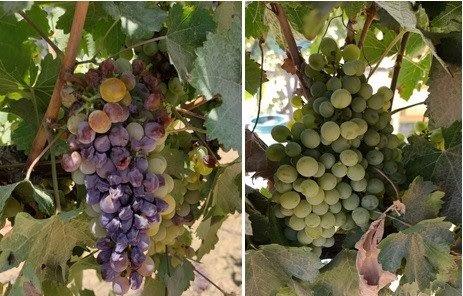
Photograph 2. On the left, a cluster (var Chenin Blanc)at the control plot, exposed to direct solar radiation. On the right, a similar cluster subjected to the influence of the agri-voltaic installation (shaded most of the day).

Figure 3. The effect of shadingby the agri-voltaic ceiling on the berry weight (A, B) and on the accumulation of sugar (brix) in the berries (C, D) during fruit ripening until harvest in two varieties:French Colombard (white), and Cabernet Sauvignon (red).
In conclusion, already at this initial stage, it is clear beyond any doubt that, Agri-Light’s managed solar ceilingcan prevent crop loss and can greatly improve the grapevine fruit quality at harvestunder the desert conditions at Ramat Negev, Israel. If there was a fear of a decrease in productionorquality due to excessive shading, it was proven wrong, at least in regards to the very critical period of ripening. Of course, these conclusions must be further examined at the end of a full year of experiments, or more.
This study is partially supported by: Israel Ministry of Agriculture and Food Security; KKL-JNF Israel; Israel Innovation Authority.
* Halutza 8551500, Israel

